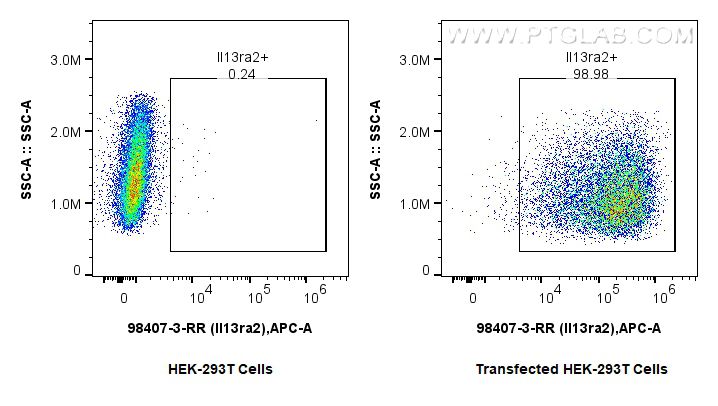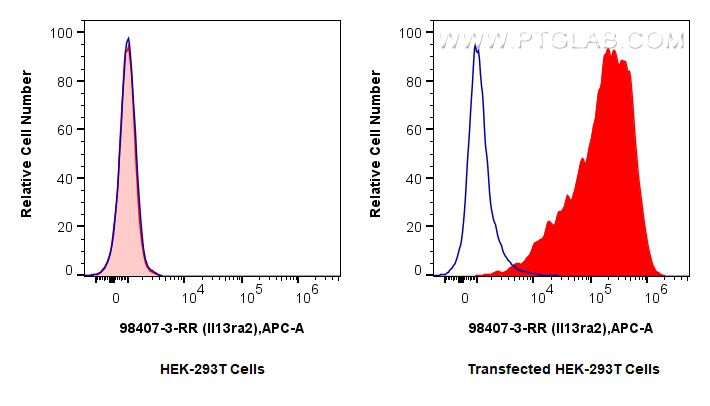验证数据展示
经过测试的应用
| Positive FC detected in | Transfected HEK-293T cells |
推荐稀释比
| 应用 | 推荐稀释比 |
|---|---|
| Flow Cytometry (FC) | FC : 0.25 ug per 10^6 cells in a 100 µl suspension |
| This reagent has been tested for flow cytometric analysis. It is recommended that this reagent should be titrated in each testing system to obtain optimal results. | |
| Sample-dependent, Check data in validation data gallery. | |
产品信息
98407-3-RR targets IL-13RA2 in FC applications and shows reactivity with mouse samples.
| 经测试应用 | FC Application Description |
| 经测试反应性 | mouse |
| 免疫原 | IL-13RA2 fusion protein Eg3118 种属同源性预测 |
| 宿主/亚型 | Rabbit / IgG |
| 抗体类别 | Recombinant |
| 产品类型 | Antibody |
| 全称 | interleukin 13 receptor, alpha 2 |
| 别名 | CD213a2, IL-13 receptor subunit alpha-2, IL-13R subunit alpha-2, Il13ra2, IL-13R-alpha-2 |
| 计算分子量 | 44 kDa |
| GenBank蛋白编号 | NM_008356.4 |
| 基因名称 | Il13ra2 |
| Gene ID (NCBI) | 16165 |
| 偶联类型 | Unconjugated |
| 形式 | Liquid |
| 纯化方式 | Protein A purification |
| UNIPROT ID | O88786-1 |
| 储存缓冲液 | PBS with 0.09% sodium azide, pH 7.3. |
| 储存条件 | Store at 2 - 8°C. Stable for one year after shipment. |
背景介绍
IL-13RA2, also named as IL-13R and CD213a2, belongs to the type I cytokine receptor family. It binds as a monomer with high affinity to interleukin-13 (IL13), but not to interleukin-4 (IL4). IL-13RA2 lacks the cytoplasmic domain for signaling, indicating that it acts as a decoy receptor. IL-13RA2 gene polymorphisms have been associated with systemic sclerosis (PMID: 16981293). Overexpression of IL-13RA2 gene has been reported in several types of cancer, including melanoma, lung cancer, and brain tumor, which makes it a potential immunotherapeutic target (PMID: 19895199; 24970476; 24021875).
实验方案
| Product Specific Protocols | |
|---|---|
| FC protocol for IL-13RA2 antibody 98407-3-RR | Download protocol |
| Standard Protocols | |
|---|---|
| Click here to view our Standard Protocols |

